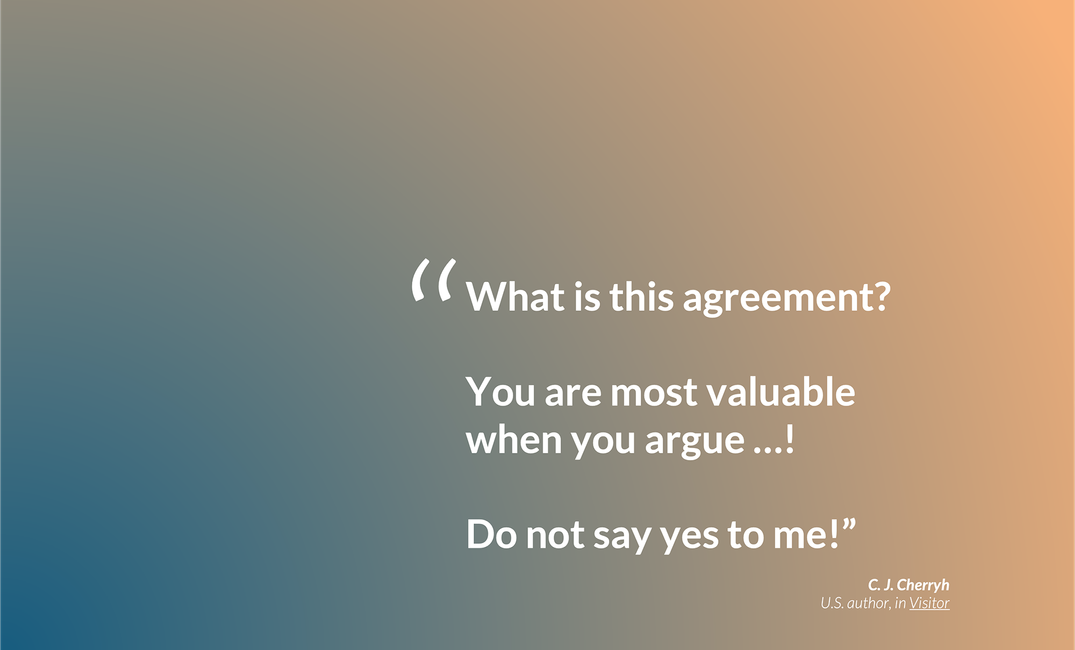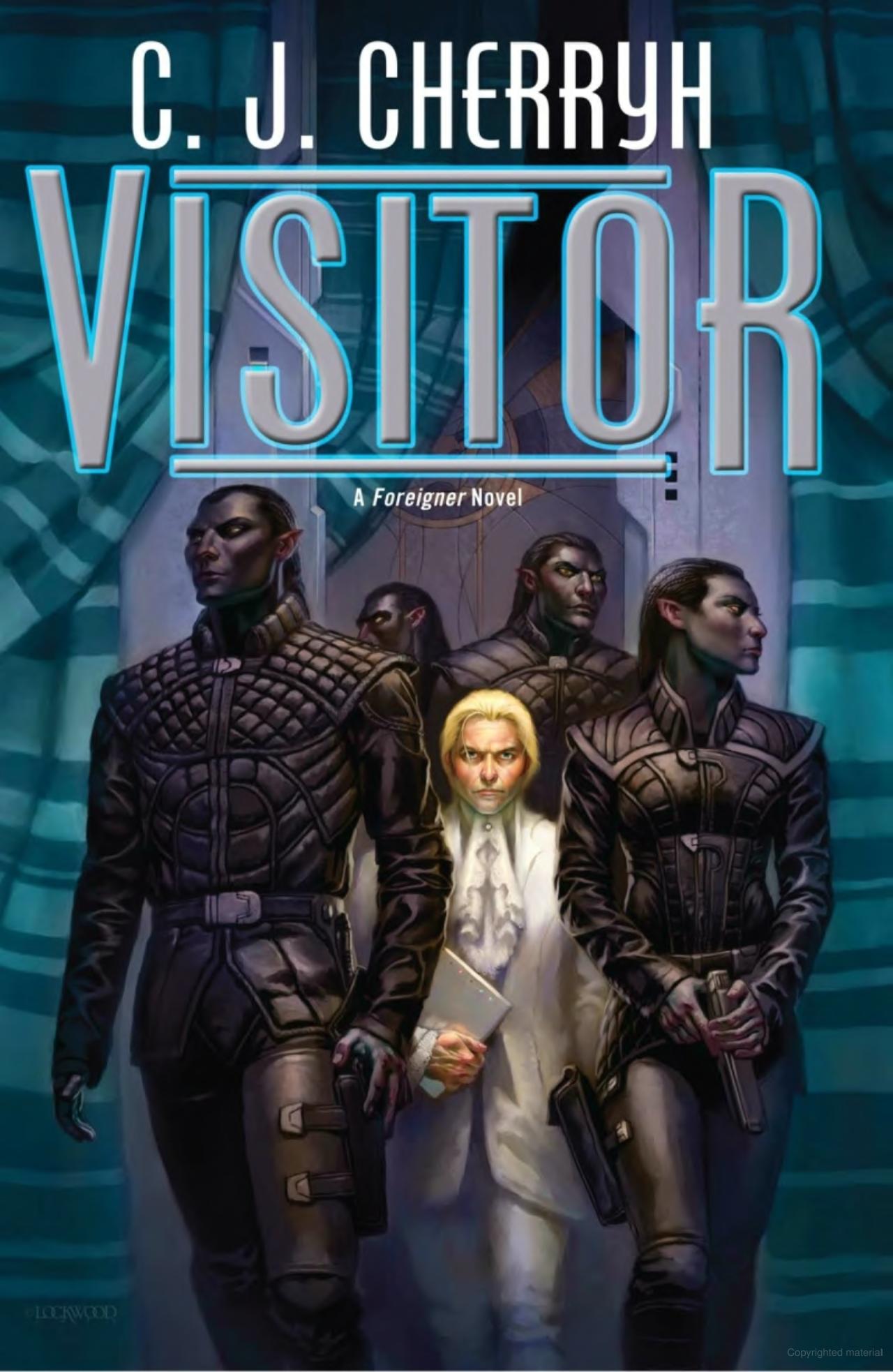"What is this agreement?
You are most valuable
when you argue ...!
Do not say yes to me!"
– C. J. Cherryh. U.S. author
The point for innovation
Good innovation work forces us to struggle with intellectual problems, impossible situations, and ideas that don't quite work yet. But all too often, innovation teams duck and settle for a half-solved problem, a less-terrible situation, and ideas that might become good maybe one day. They do it even if it's critical not to.
Why even struggle on?
In corporate innovation work, as in other creative disciplines, we have infinite options for what to create. Even if we scope projects tightly, there still are so many more options than we can test in a lifetime (yes, even with AI), that the options might as well be infinite.
And that means that most ideas are crap.
Crap that seems cool on the surface, to be sure. But still ideas that will one day end up among the vast majority of implemented "solutions" that didn't actually work out.
That's not a dig on innovation teams. With so many options and so many variables to consider at once–from what a certain user segment will desire to what our lawyers will clear for launch–the chance are simply quite high that we think something will work, based on what de-risking we have done to-date, that in the end falls flat anyway. There are just too many options.
But ...
when we do struggle on and do manage to find an elusive option that truly works, things can suddenly fall into place.
And when things fall into place, you instantly know it. Then, when you explain it to others and they too instantly agree, you know you are really onto something.
(By the way, for a good method for achieving such breakthroughs, check out Prof. Sheena Iyengar's book Think Bigger. It'll still be hard work. But a reliable set of steps is there.)
The problem is that once you have experienced that feeling, you also know when you don't have it yet on the next project. You know that you haven't achieved the breakthrough to a great answer to the issue at hand yet. But you can't force a breakthrough. You must struggle with it.
So we must struggle on to reach something good among the infinite options that are mostly bad.
If it's so important, doesn't everyone do it?
The problem with fighting on until you reach a breakthrough is not just that it's hard. That's obvious. It also runs counter to the core spirit of several types of innovation teams.
In other words, continuing on means directly defying the tendencies of many teams.
I'm generalizing here of course, as well as highlighting a few of the most common problems. Each team is unique. And of course, these issues don't affect all teams, and not all the time.
But directionally, you might recognize these traps from teams you have encountered or think of other, similar ones that can ensnare teams when they are not being their best selves:
- Human-centered design (HCD) teams can get caught in two traps: First, there's toxic positivity, where there is so much of a push to build on each others' ideas, to have empathy for users, and so on that nobody calls out directly what ideas are simply not remotely good enough yet. The teams don't struggle as hard as they need to because it would involve more disagreement than they can handle. And second, they can get so stuck in the mode of thinking of ever better solutions that might be awesome some day that nobody brings people back to the requirements of what we can actually pull off and get people to buy today.
- Strategy-centric teams can get caught in their insistence on "starting with the end in mind," by which they mean that they use logic and helpful mental models to come up with a reasonably decent hypothesis for a solution at the very start of the project. From then on, they can spend time validating or adjusting the hypothesized solution, because they saved themselves the time it would have taken to create a solution from scratch. Normally, that works fine. but very transformational and dynamic situations simply don't fit such an approach. If things change quickly, the team keeps having to come up with new hypotheses for the new situation. And if things are changing transformationally, the patterns and logic of today may not apply or at least apply only in a way that is not apparent yet. Instead of admitting defeat and trying something different, teams can instead double down, shape some mental framework to fit anyway, and forge on with a "bias for action," pushing to implement something for which they then have to reverse-engineer a supporting argument that may or may not work.
- Entrepreneurial teams can get caught in the lure of "simply testing everything." Of course, the process appears solid. And plenty of confident-looking startup billionaires on conference stages proclaim the absolute, unfailing truth of "Lean Startup," "Product-Led Growth," and other buzzwords. But the sheer rates of failure among startups (i.e., outcomes) should give one pause. Then add to it that a good share of companies that become commercially successful mostly copied others and succeeded via successful competition, not innovation, and again, something might not have worked. What? The existential pressure for extreme speed. VC-funded companies in particular must achieve such absurd growth rates that any pause to think long and hard about something seems like an absurd luxury; utterly unrealistic. Despite the occasional story of a major "pivot," startups are increasingly becoming single-shot bets with minor ability to fine-tune that simply play out over the course of two to ten years, at a frenetic pace. Struggling to get it right is not an option.
I write about these teams because I know them best.
But surely, you can find the same temptation to avoid the hard work of developing your best ideas if you work in a Venture Studio, an Open Innovation Team, Accelerator, M&A team, or any other of the vast range of innovation team types. The specifics will differ. But the core problem remains.
So what's a team to do?
This, at last, is where we come back to our quote.
C. J. Cherryh is a major force in U.S. science fiction writing. This particular quote stems from a novel in her "Foreigner" series. (By the way, the character who speaks here is fantastic, one of my all-time favorites.)
Cherryh reminds us that it may often be nearly impossible to avoid the temptation to give up too soon. We may not be able to do it often on our own (though it can happen at times of course). In general, we are much more likely to succeed if we have a trusted outsider who will disagree with us, productively and in a way to which we are willing to listen.
Even then, I have learned as a longtime consultant that it takes effort simultaneously to keep up one's outsider's status, the client's trust, and the perspective to have insightful, honest counsel to offer. It is not easy, just as the quote also points out. But at least, the independence of an outsider does make it possible.
So find trusted outsiders--outside your team, your function, company, industry, ... the specifics don't matter that much, but an outsider with enough understanding of your situation to offer competent advice. Then cultivate mutual trust and invest it in productive disagreement.
(Lest you think that this is a roundabout sales pitch for consultants: Not so. Consultants too have incentives and biases, some of them really not in clients' interest or a good match for this specific challenge. Someone is just not automatically a good partner in the struggle for great ideas, not to you or anyone, just because they are a consultant. Find the right person for you, no matter where you find them.)
Cherryh isn't the only wise person sharing this advice. For example, former General Motors CEO Alfred Sloan has been attributed to have said:
"If we are all in agreement on the decision--
then I propose we postpone further discussion of this matter
until our next meeting to give ourselves time to develop disagreement
and perhaps gain some understanding of what the decision is about."
Disagreement and struggle in the service of an idea that truly works are both necessary and hard. They take cultivation, in partnership with others who are willing to help you disagree productively.
Source
Further reading
Cherryh, C. J. (2016). Visitor. Penguin. http://books.google.com/books?id=UzGJEAAAQBAJ&hl=&source=gbs_api
Iyengar, S. (2023). Think Bigger: How to Innovate. Columbia Business School Publishing. http://books.google.com/books?id=ECRMzwEACAAJ&hl=&source=gbs_api



